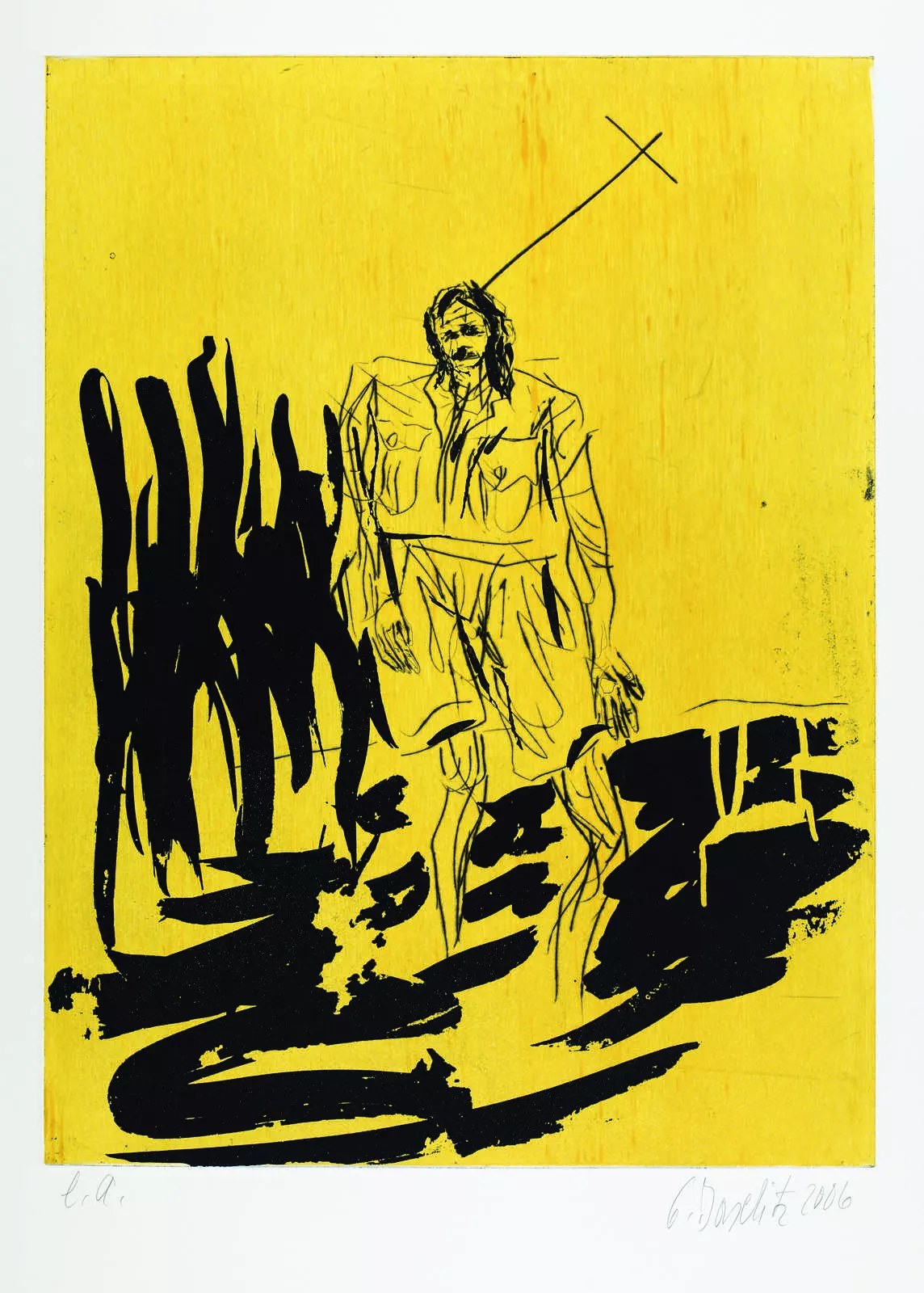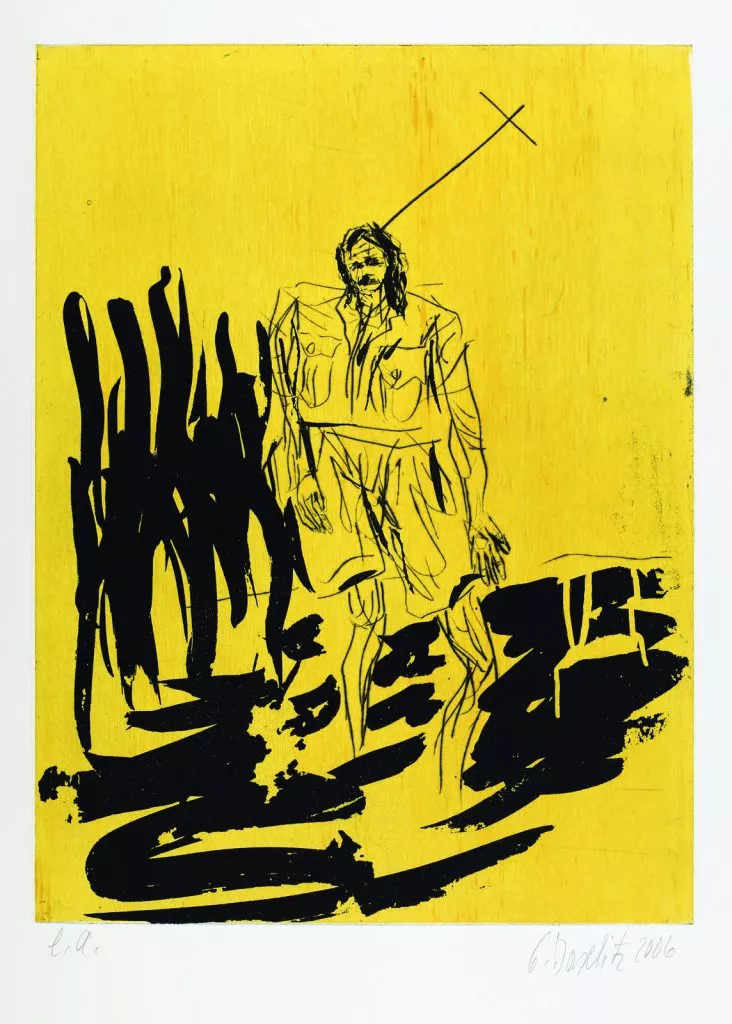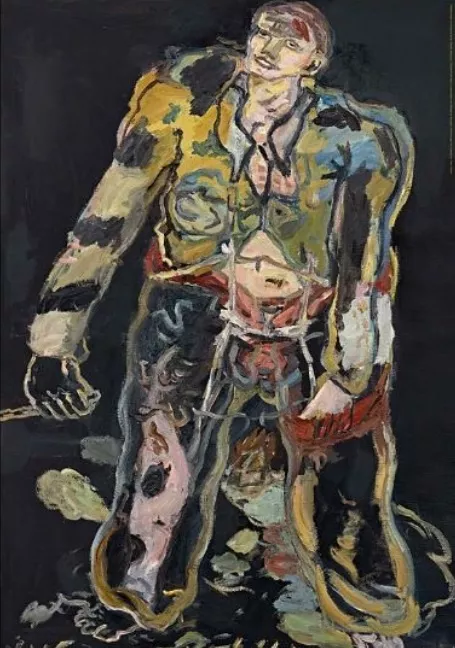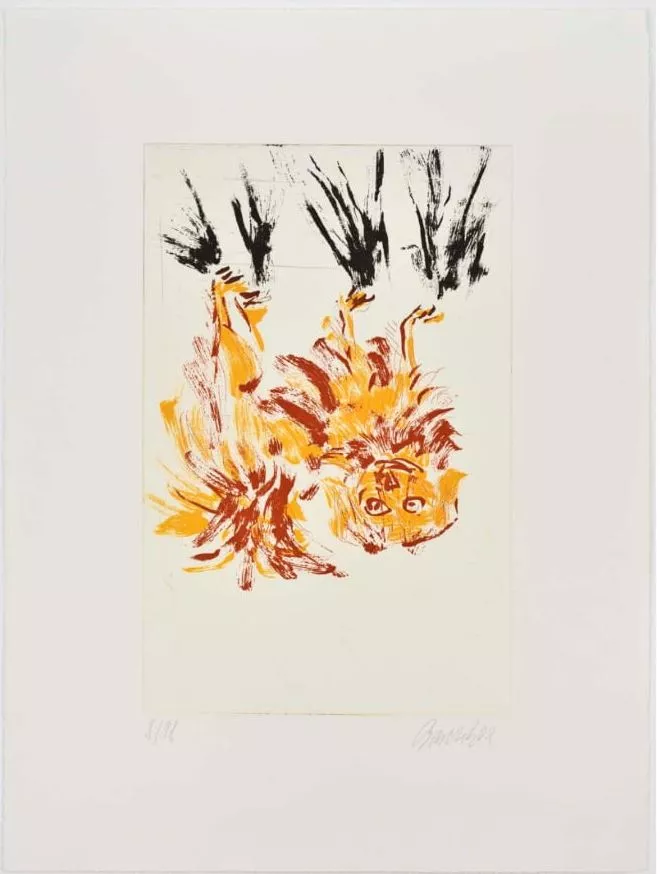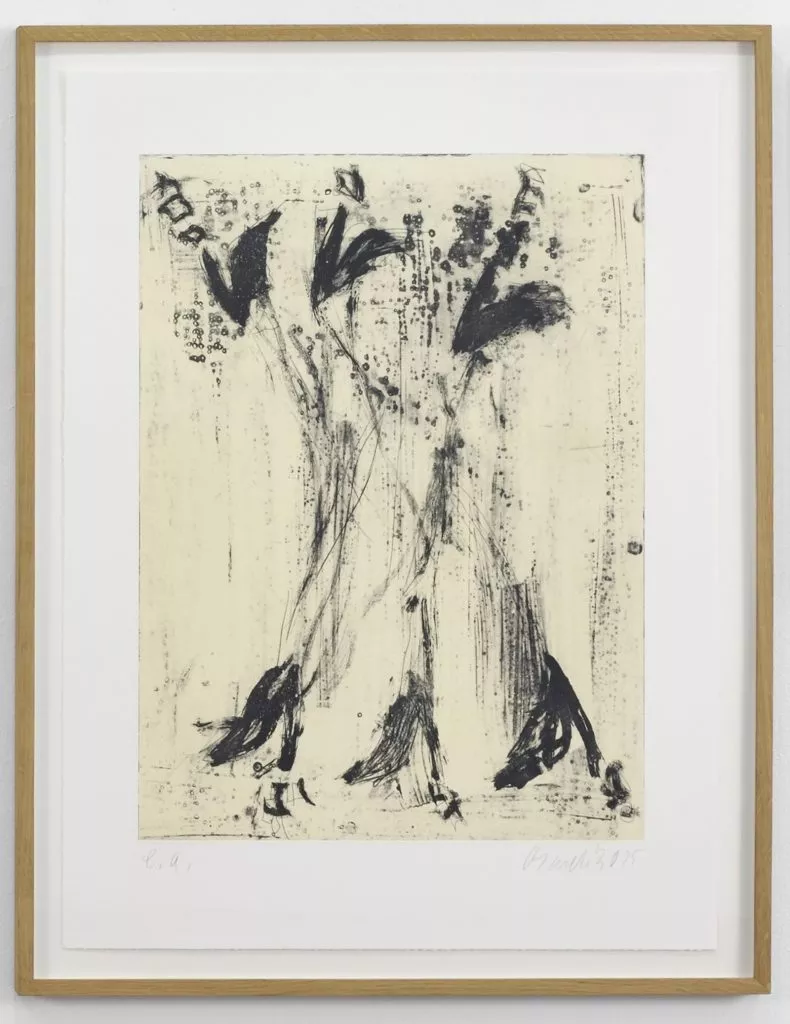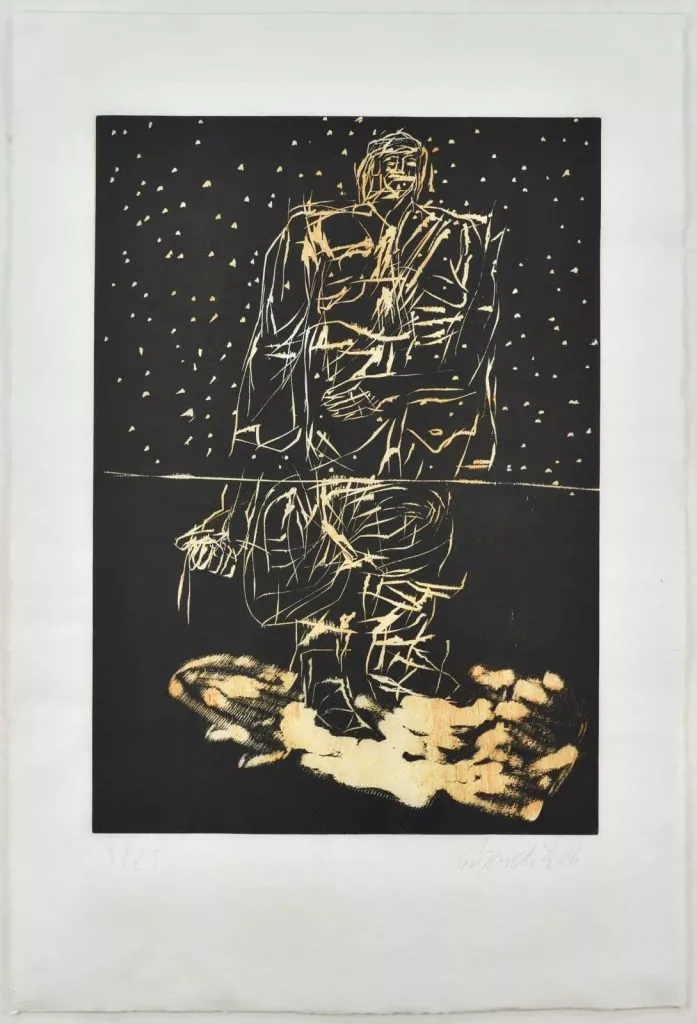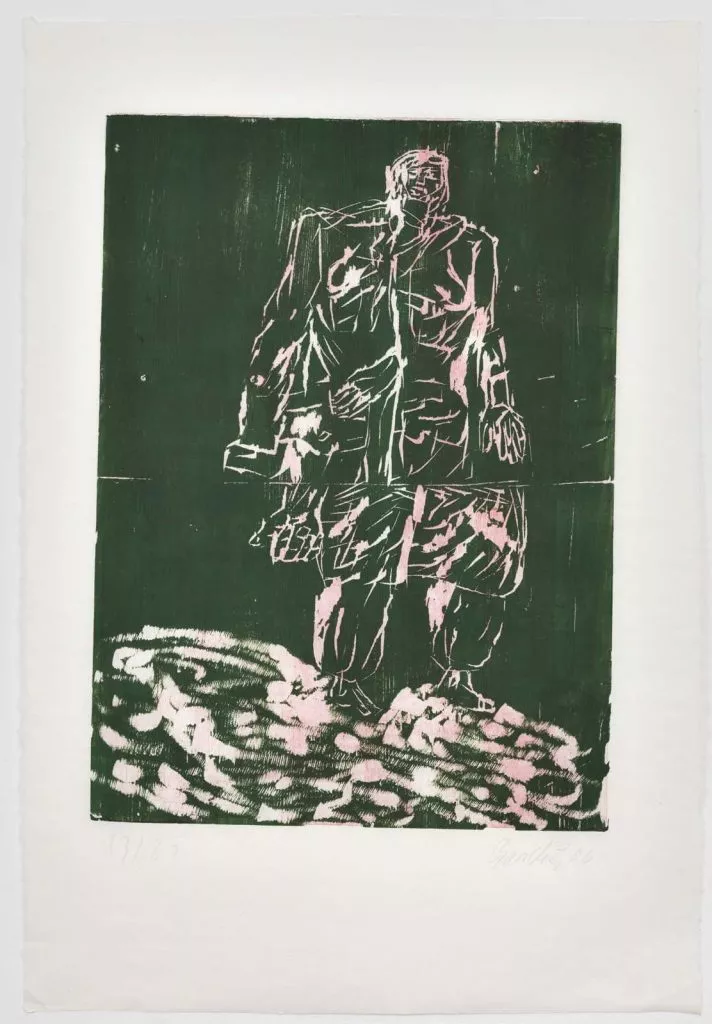Georg Baselitz: Der Hirte (Shepherd) (Remix), 2006, aquatint and drypoint, signed, numbered, limited edition 20 copies, here: e.a., size: 85 x 65 cm. Price € 7.000.- Order here!
About Georg Baselitz
Painter, sculptor, printmaker and draughtsman, Georg Baselitz is one of Germany’s most celebrated living artists, with a distinguished career spanning over fifty years. Born Hans-Georg Kern in 1938, he grew up in Saxony, an area that later became East Germany. Whilst studying painting at the Academy of Art in East Berlin (1956) he was sent down after one year for ‚political immaturity‘.He then applied at the Academy in West Berlin and moved there in 1958, completing his studies in 1962. During this period he adopted the surname Baselitz, reflecting his place of birth Deutschbaselitz. In searching for alternatives to the strongly narrative art of Social Realism and abstract painting, he became interested in art considered to be outside of the mainstream of Modernism. He began to look to Ferdinand v. Rayski, Michail Wrubel amomgst others and imagery that was rooted in the Art Brut. He was also inspired by Existentialist art and literature (Fautrier, Beckett, Ionesco, Artaud), by Dada (Schwitters, Picabia) and the works of the German authors Nietzsche and Gottfried Benn.
Baselitz’s first solo exhibition in 1963 at Galerie Werner & Katz, Berlin, caused a public scandal and several paintings were confiscated by the German authorities claiming that they were publicly indecent. Among them Die grosse Nacht im Eimer (‘The Big Night Down the Drain’), which depicted a masturbating dwarf-like figure. By the mid-1960s, Baselitz embarked on a series of paintings depicting monumental male figures, which he described as Rebels, Shepherds or New Types (‘Ein neuer Typ’). Viewed within the Romantic tradition, the rebel (or hero/partisan) is often regarded as an outsider associated with the figure of the artist. These paintings are often termed as the ‘Hero’ (‘Helden’) series and were prompted after Baselitz’s scholarship in Florence in 1965, where he became interested in Italian Mannerist prints. Baselitz depicted his figures located within mythical, ruined landscapes, each with symbolic attributes to identify their individual characters, such as army boots, knapsacks or uniform jackets, often with exaggerated and exposed sexual organs. The lone figure as a prophet or saint also alludes to home coming soldiers stumbling, dazed, through battle-scarred post-war Germany.
The ‘Fracture’ paintings of the late 1960s revealed Baselitz’s keen interest in forests and trees (and the motifs that have historically been associated with them, with rural landscapes peopled with woodsmen and hunters). They were divided into segments so that the imagery could be reorganised pictorially. In 1969, he decided to create and display work upside down in order to re-focus the viewer on the pure pictorial merits of the painting. By attempting to overcome the representational, content-driven character of his earlier work, this also enabled him to emphasise the qualities of the composition independently from the motif.
By the late 1970s, he was making monumental sculptures of figures and heads with rudimentary and deliberately irregular forms. He used wood, he said, because “it enables avoidance of any attractiveness of form, any craft or elegance … objects in wood are unique, simple, unpretentious”. Having spent most of the early 1970s apparently working outside the mainstream, dominated at the time by Conceptual Art practice, by the 1980s he had established his international reputation (cemented by exhibitions such as the Venice Biennale in 1980 and ‘A New Spirit in Painting’ in 1981). During the 1980s and early 1990s, the canvases became denser and more heavily worked, and subject matter returned to play a greater role. He began introducing motifs from Slavic folk art, sometimes combining motifs with figures of family members taken from old photographs. The styles of German Romanticism inspired his more recent work and he even addressed works created in the Socialist Realism of Stalin’s era (which he rejected so forcefully at the beginning of his career). In 2005 Baselitz introduced the ‘Remix’ in his work, in which he has returned to key phases of his own art history (including ‘ The Big Night Down the Drain’ and ‘The Great Friends’) and made new versions of his work. They are painted intuitively, with quick and spontaneous flashes of bright, transparent colour. References to the Nazi leader Hitler, which in the earlier works had been more ambiguous, are more directly emphasised. These works have allowed Baselitz to revisit and excavate the past, pushing his own painterly vocabulary to create works that are fresh and liberated. Georg Baselitz lives and works in Basel, Switzerland, at lake Ammersee, Germany and in Imperia, Italy.
Georg Baselitz: Rebell, Offset print, 2016, based on the oil painting of the same name in 1965, size: 70 x 100 cm © Georg Baselitz 2016. Tate London 2015. PhotoFredrich Rosentiel.Price EUR 195.-
Georg Baselitz: Vier Spitzen 2002, Etching and Aquatint, edition of 18, size: 75,5 x 57 cm, signed and numbered. Priec 4.500.- Order here!
Georg Baselitz: Ich höre Stimmen (I hear voices), 2015, aquatint and drypoint on black coloured Somerset 300 g/m² , signed, numbered, lim. edition 10 copies, here: e.a., size: 85 x 65 cm. Price € 7.000.- (without framing). Order here!
Georg Baselitz: Hirte,2006-2007, Colour woodcut, signed, numbered, limited edition of 25 copies. Size: 97,5 x 65,5 cm. Price € 7.500.- Order here!
Georg Baselitz: Mantel (coat), 2006-2007, Colour woodcut, signed, numbered, limited edition of 25 copies. Size: 97,5 x 65,5 cm. Preis € 7.500.- Order here!
